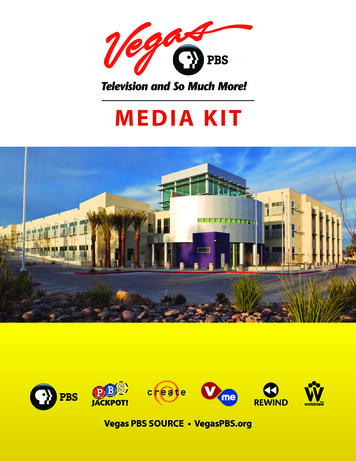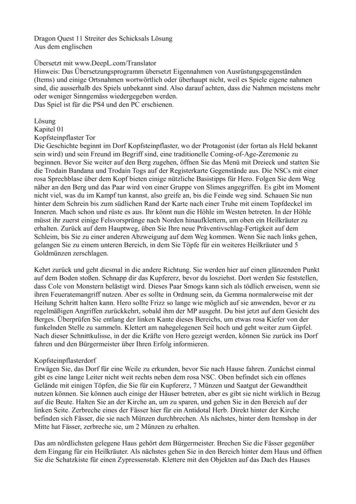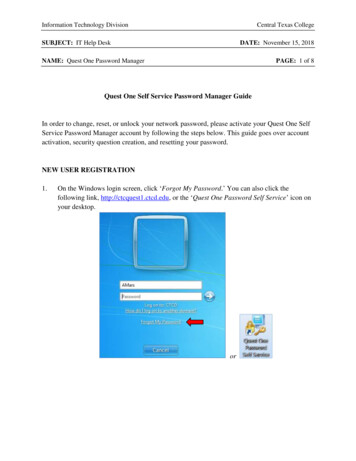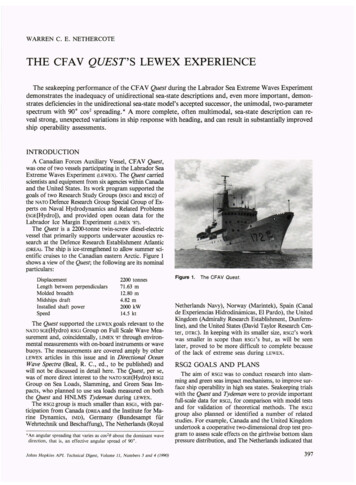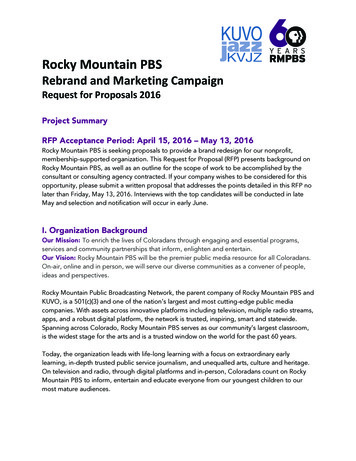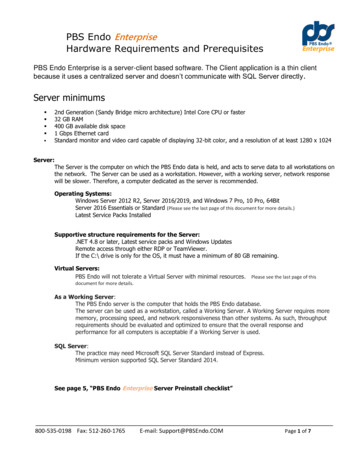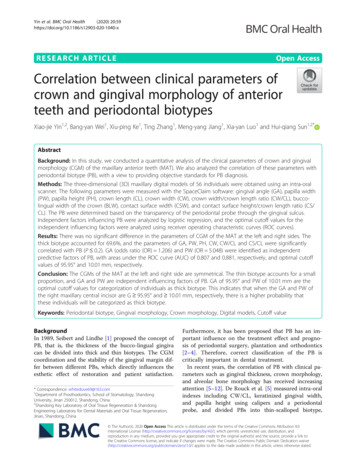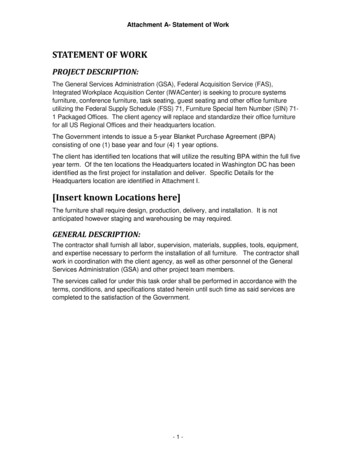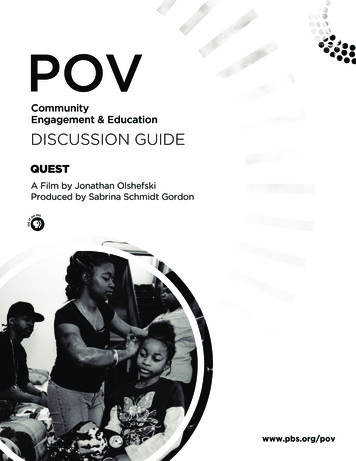
Transcription
POVCommunityEngagement & EducationDISCUSSION GUIDEQUESTA Film by Jonathan OlshefskiProduced by Sabrina Schmidt Gordonwww.pbs.org/pov
LETTERS FROM THE FILMMAKERSIn 2006 I was teaching a still photography class in North Philadelphia. One dayafter class, one of my students came up to me and said, “My brother runs a hiphop studio out of his house a couple of blocks away. Do you want to meet him?”So we end up walking down the street, and James introduced me to his brotherChristopher Rainey, aka Quest. We exchanged business cards and a few weekslater Quest invited me to come to his home studio (Everquest Recordings) totake photos to help promote his artists.When I first visited the studio I was really drawn to the community. The energyand passion were just captivating. I wanted to contribute in any way that I could,so I began working on a photo essay about the studio while also taking picturesfor artists to use as album art. One of the rappers, Price, started calling me PeterParker, as I was climbing all over the place trying to get interesting angles. Thename stuck and that is what everyone in the neighborhood calls me to this day.As I spent more time with the Rainey family, I realized that layers of their experience were the essence of a story. They were not only managing the studio thatthey created to provide a safe space in the neighborhood, but also raising theirchildren and holding down working-class jobs to make ends meet. I’d never madea documentary before, but in 2007 we decided to make a “short, little documentary,” and a ten-year filmmaking journey began. Over the years life imposeda series of twists and turns on the family, and I simply followed along through theDirector Jonathan Olshefski.quiet moments and also times of crisis.Photo courtesy of Holly OlshefskiPhiladelphia is often at the top of annual lists tracking poverty statistics and percapita homicides. North Philadelphia is a neighborhood that tends to be defined from the outside. The evening news talliesdaily tragedies and constructs a portrait of a scary and depressing place. These depictions fail to reflect the complexity andbeauty of the community. North Philadelphia certainly faces significant obstacles, but it should be defined not by those obstacles, but on its own terms. QUEST is an attempt to reveal the nuances of a community from the point of view of the people who actually live there.The Raineys are an incredible family and truly emblematic of what North Philadelphia has to offer, which often goes unrecognized. They love their neighborhood and are deeply invested in it. They build community and sacrifice their time, talents,and resources to make it a better place. They exhibit courage and compassion when faced with hard times and extend a handto others when they are down. They also know how to have fun and celebrate life. Their block parties are not to be missed.Over the years they have shown incredible kindness to my family and me. I hope that viewers are able to feel just a fractionof the warmth and vicarious joy I experienced while spending time with the Raineys.We are living in an incredibly polarized time. Ignorance and fear divide people who actually have much in common. QUESTis an invitation for viewers to experience life from the point of view of the Raineys and to reflect on their own lives and relationships. My hope is that viewers will connect deeply and be encouraged, inspired and challenged by the Rainey family’sstory. I hope viewers then live out this sense of connection as active participants rather than passive viewers and actually getinvolved in making a positive impact on families like the Raineys and places like North Philadelphia and push society to address the myriad unjust forces that threaten their hopes, dreams and very lives.I make movies to make friends, and my friendship with the Rainey family sustained this project through many years of notknowing whether it would be even be a film, much less one anyone would watch. QUEST was certainly a labor of love and Iwas often on the receiving end of that love. I am very privileged to have had the opportunity to collaborate with this amazing family.Jonathan Olshefski (aka Peter Parker)Director, QUESTDISCUSSION GUIDEQUEST 2
LETTERS FROM THE FILMMAKERSWhen Jonathan approached me to collaborate on QUEST, I was, admittedly, a littlebit hesitant. He was a White filmmaker who had spent years following the Raineys,a Black family living in Philadelphia. At first, it sounded like another version of thewell-worn, reductive narratives often made by White filmmakers about Black folks—particularly, the most vulnerable among us—who struggle with poverty, addiction, violence, and more. But as I watched hours of raw footage, Jonathan’s patience anddedication to filming the “quiet moments” for nearly a decade gave way to a profound intimacy, and an opportunity: to disrupt the stereotypical narrative of Black lifein the ‘hood, and to offer, instead, a nuanced, complex portrait of a loving familymaking their way in a neglected and underserved neighborhood.Representation and images matter. We all want to see ourselves reflected with authenticity, to have our stories told in a way where we recognize ourselves in them.With QUEST, I wanted to amplify the thoughtfulness, humor, intellect, love, and vulnerability that the Raineys demonstrate in their daily lives. For me, it was abouttelling a story that is insightful, not voyeuristic; about telling a story that does not demonize or mythologize, but instead, fosters recognition over curiosity, empathy overpity, and dignity over pathology.In the decade that we follow the Raineys, they are confronted by some of the mostdifficult and urgent issues plaguing our society. I think one of QUEST’s greateststrengths is that it vividly illustrates how these issues are interconnected, and it pro-Producer Sabrina Schmidt Gordon.vides an opportunity for audiences to cultivate deeper understanding and connec-Photo courtesy of Rashid Zakattion to communities that are navigating these challenges every day.Following a traumatic event, the Raineys generously decide to keep the doors opento their home studio. Their decision to continue to say, “Come in,” is a testament totheir unwavering love and commitment to their North Philly neighborhood. As weshare the film with communities across the country, I hope that people will be inspired by the Rainey’s love, optimism, hope, and healing. This is the heart of theirstory.Sabrina Schmidt GordonProducer, QUESTDISCUSSION GUIDEQUEST 3
TABLE OF CONTENTSCREDITS2Letters from the FilmmakersWriter5IntroductionFaith Rogow, PhD6Potential PartnersInsighters Educational Consulting6Key Issues7Using This Guide8Selected People Featured in QUEST9General Discussion Questions10Discussion Prompts17Taking Action18Resources21How to Buy the FilmImpact Producer and ResearcherSabrina Schmidt Gordon,Producer, QUEST, The Engage Media ProjectGuide Producers, POVAlice QuinlanManager, Community Engagement and Education, POVIone BarrowsAssociate, Community Engagement and Education, POVCopy Editor:Natalie DanfordDesign:Rafael JiménezThanks to those who reviewed this guide:Michael O’BryanDirector of Youth and Young Adult Programs, The Village ofArts and HumanitiesCharlene CarruthersNational Director, BYP100Leslie Fields-CruzExecutive Director, Black Public MediaDISCUSSION GUIDEQUEST 4
INTRODUCTIONThe Raineys.Photo courtesy of Jonathan OlshefskiFilmed with vérité intimacy for nearly a decade, QUEST is the moving documentary portrait of the Rainey family living in NorthPhiladelphia. Beginning at the dawn of the Obama presidency, Christopher “Quest” Rainey and his wife, Christine’a “Ma Quest,”raise a family while nurturing a community of hip hop artists in their home music studio. It's a safe space where all are welcome, but this creative sanctuary can’t always shield them from the strife that grips their neighborhood. Epic in scope, QUESTis a vivid illumination of race and class in America, and a testament to love, healing and hope.DISCUSSION GUIDEQUEST 5
KEY ISSUESPOTENTIAL PARTNERSQUEST is well suited for use in a varietyQUEST is an excellent tool for outreach and will be of special interest toof settings and is especiallypeople looking to explore the following topics:recommended for use with: African-American families parenting American culture Philadelphia Black Lives Matter police, policing andrelating to urban life, family, civic engagementAfrican Americans, poverty and community-based activism race and racism community-driven rap musicsolutions relationships Your local PBS station Groups that have discussedprevious PBS and POV filmsresilience, including All theDifference, American Promise, Offand Running, Raising Bertie and Do Not Resist community empowerment resilienceGroups focused on any of the crime prevention socioeconomic classissues listed in the Key Issues disability sociologysection education stereotypes andHigh school students, youth gun violence healing (through musicgroups and clubs Faith-based organizations andinstitutions Political, public policy and socialservice leaders and staff Cultural, art and historical organizations, institutions and museums Civic, fraternal and communitygroups profilingAcademic departments andstudent groups at colleges,prejudices narrativesand the arts in general) health care and publicstorytelling/creating new trauma/healing fromtraumapolicyintergenerational urban liferelationships vérité documentary intersectionality youth leadership working class/working LGBTQ issues mentoring pooruniversities and high schools Community organizations with amission to promote educationand learning, such as locallibrariesDISCUSSION GUIDEQUEST 6
USING THIS GUIDEThis guide is an invitation to dialogue. It is based on a beliefAudience members will bring their own unique perspectivein the power of human connection, designed for anyone whoand background. Audience members may also include thosewants to use QUEST to engage family, friends, classmates,who resonate on a deeply personal level with the issues incolleagues and communities. This document envisions con-the film. Before beginning the conversation, you may wantversations undertaken in a spirit of openness in which peo-to remind the group of this and encourage participants tople try to understand one another and expand their thinkinghelp establish an atmosphere that is open and respectful toby sharing viewpoints and listening actively.all perspectives.The discussion prompts are intentionally crafted to help aFor more detailed event planning and facilitation tips, visitwide range of audiences think more deeply about the issueswww.pov.org/engagein the film. Choose one or two that best meet your needsand interests. And be sure to leave time to consider takingaction. Planning next steps can help people leave the roomfeeling energized and optimistic, even in instances whenconversations have been difficult.The subject matter of QUEST is intense and may provoke strong reactions. Each audience member willbring their own unique perspective and background, and some may be personally triggered by the film.Before beginning the conversation, you may want to remind the group of this and encourage participants to help establish an atmosphere that is open and respectful to all perspectives. Consider establishing ground rules for the conversation that emphasize active listening and respect.Facilitators should keep an eye out for audience members who become especially upset. Be preparedto take them aside and follow up with a referral to local professionals and support services. Rememberthat people respond to trauma in different ways. In addition to tears or panic, trauma can look like: “spacing out,” silence, laughter or jokes during “inappropriate” moments or anger.DISCUSSION GUIDEQUEST 7
SELECT PEOPLESelected People Featured in QUESTChristopher “Quest” Rainey – husband to Christine’a, fatherChristine’a “Ma Quest” Rainey – mother to PJ and Will andto PJ and music studio ownerQuest’s wifePatricia “PJ” Rainey – Quest and Christine’a’s daughter and aWilliam "Will" Withers and his son Isaiah – Christine’a’s songun violence survivorand a cancer survivorPrice – a rapper and regular at the music studioDISCUSSION GUIDEQUEST 8
GENERAL DISCUSSION QUESTIONSImmediately after the film, you may want to give people aAt the end of your discussion, to help people synthesizefew quiet moments to reflect on what they have seen orwhat they’ve experienced and move the focus from dia-pose a general question (examples below) and give peoplelogue to action steps, you may want to choose one ofsome time to themselves to jot down or think about theirthese questions:answers before opening the discussion: What did you learn from this film that you wisheveryone knew? What would change if everyonewould you say?knew it?If you could ask anyone in the film a single question, If you could require one person (or one group) towhom would you ask? What would you ask?view this film, who would it be? What would youWhat did you learn from this film? What insights didhope their main takeaway would be?it provide? If a friend asked you what this film was about, whatDescribe a moment or scene in the film that you Complete this sentence: I am inspired by this film (ordiscussion) to .found particularly disturbing or moving. What was itabout that scene that was especially compelling foryou? List the emotions you experienced throughout thefilm. What prompted that reaction?Prior to viewing, imagine that you are working for an ad agency making TV commercials and you receiveinstructions to make an ad featuring an “all-American family.” Jot down what you’d look for when casting and how you would convey to an audience that this is an “all-American family.” Where does the family live? What do family members look like? What are they wearing? How many people are in the familyand how are they related to one another? What are the sources of their income? What music do theylisten to? Do they adhere to a particular faith tradition? What are their prize possessions? What are theircore values and how do they express those values? What language you would use?Set aside your notes and view the film.After viewing, look at your description and compare it to the Rainey family. Would you have cast themas an all-American family? If not, why not? If yes, what about them makes them good representativesof what it means to be American?DISCUSSION GUIDEQUEST 9
DISCUSSION PROMPTSQuest delivering newspapers.Constructing CommunityPhoto courtesy of Jonathan OlshefskiQuest characterizes his community as follows: “We are moreabout the streets and everybody just hanging out as awhole. When you talk to people you find out they are not ashard as they appear to be.” How would you characterize thecommunity you see in the film? What are its major strengthsand vulnerabilities? Did you have preconceived notionsabout this community or communities like it? If so, whatwere they? After watching the film, has your understandingDrawing from what you see in the film, what are Trump andothers who share his view of communities like these missing? How could you more accurately describe the community?After PJ is shot, a local Philadelphia reporter arrives butof this community and those like it changed at all? If so,doesn’t know what neighborhood he’s in. Does that revealhow? How does it compare to your own community?anything about how the neighborhood is seen (or not seen)As shown in the film, then-presidential candidate DonaldTrump courts African-American voters by asking, “What doyou have to lose? . It is a disaster the way African Ameri-by people outside of it? What does that reveal about howthe neighborhood is regarded? How do you think that affects the reporter’s coverage?cans are living in many cases.” Why do you think theRaineys don’t find Trump’s argument convincing?DISCUSSION GUIDEQUEST 10
DISCUSSION PROMPTSCivic EngagementThe film opens with the Raineys urging friends and family tovote. Why do you think the filmmaker chose to emphasizethis?trauma of a single person or family? Have you ever been affected this way? How many people do you think are directlyor indirectly impacted by an act of violence like a shooting?Can you list them all? Examples include: immediate familymembers, extended family members, friends, schools/class-Would you describe the Raineys as activists? Organizers?mates, neighbors, nurses, doctors, ambulance drivers, socialWhy or why not? How would you describe the differenceworkers, chaplains, etc.between these two terms?After PJ is shot, Christine’a says, “At first sleeping was hard.Quest says, “It feels like no one cares about this section ofWhen we first came home for her to get up in the morningthe city.” He calls it “ridiculous” that politicians can find timeand for her to come downstairs to see the patch on her eyeand resources to build another prison or casino, but not toto remember that it was real, it wasn’t a dream. There’sprovide “something for the kids after school so they wouldanger and sadness and confusion.” How do these traumatichave something to do.” How do you think elected officialsevents impact families, friends, and the community? Doescould better serve the North Philly community? What wouldsociety support the healing of the community? How can weyou want to invest in for North Philly, or for your commu-support collective healing as well as individual healing?nity? (Possible answers include workforce development,green space, a playground, a computer lab, an after-schoolprogram or programs for music, art and sports.) What couldpeople do in order to be part of the decision-makingprocesses of their elected officials? How could communitieslike North Philadelphia hold elected officials accountable forinvestment in the neighborhood and better resources?Americans are taught that in the United States, anyone whoworks hard will be rewarded with financial success. Clearlyboth Christine’a and Quest work very hard, so what explainstheir financial insecurity? What would have to change inorder for the Raineys’ economic status to reflect their workethic and dedication to community?Like many of their neighbors, the Raineys are frustrated byintractable problems of violence, crime, injustice andpoverty. Yet they remain active, investing their time, energyand scarce resources to keep their music studio open. WhatWhen we see PJ at the doctor’s office to get her prostheticeye fitted, we are reminded of the physical aftermath of theshooting. After the news cameras and well-wishers are gone,do we forget about the ongoing struggle of victims livingwith their injuries? Does society do enough to support thehealing process for victims of trauma? How can we supportvictims in their ongoing, lifetime recovery processes?How does the community try to make sense of PJ (and otheryoung people) getting shot? What explanations do community members offer? How does this compare with the explanations offered by observers from outside the community,such as politicians or pundits?Quest says that PJ is “blaming herself for getting shot.” Inturn, he blames himself for allowing her to be out on thestreet. If you were a friend of theirs, how would you respondto their expressions of guilt?do people like the Raineys contribute to their communities,Christine’a can’t walk by the block where PJ was shot with-despite not having lots of money or resources? Who are theout remembering that her daughter almost died there, whilepeople in your community who are like the Raineys? WhatQuest says PJ gets the creeps in that spot. What does thiscould you do to support their efforts?tell you about the lasting effects of violence on communities? How do you think it feels to see reminders of traumaGun Violencearound one’s neighborhood?The film includes remarks from President Obama after aWhy is it important to have a community gathering to wel-mass shooting in which he notes that no matter where thecome PJ home from the hospital?violence occurs, “these neighborhoods are our neighbor-At the block party to celebrate PJ’s recovery from the shoot-hoods; these children are our children.” What do you thinking, Adia, sobbing, says to her, “You’ve got me messed upwould change if Americans saw every victim of gun violenceright here. You look like you’re okay. And I’m not. That’s theas “our children” and every resident of communities likeproblem.” What does she mean by that? What did youNorth Philadelphia as “our” neighbors? Brainstorm tangiblelearn from this and other scenes about the waysand achievable action steps as a group to change this nar-everyone in the community is affected by therative.DISCUSSION GUIDEQUEST 11
DISCUSSION PROMPTSQuest.How does mainstream news coverage of and social mediaPhoto courtesy of Jonathan Olshefskiabout the ongoing violence in communities of color differfrom the public conversation that occurs after mass shootings? How can different communities affected by gun violence reframe the conversation and build unity around thistrast this with Quest’s interaction with police when he isissue?stopped and frisked because his white t-shirt and jeans al-PJ is annoyed by the attention she receives when she returnshome after the shooting. Why are well-meaning commentslike “you’re still pretty” not very helpful? What values areconveyed to PJ by the focus on her physical appearance?legedly match the description of a suspect. Which of thesetwo scenes is a better reflection of your experience of policebehavior? Does either of these scenes make you secondguess your perception of the police in your community?What do you think makes a difference in how the police interact with the community?Police and Community RelationsWhy does Christine’a pull out her phone when Quest is beingChristine’a says appreciatively, “The cop that drove me andfrisked by the police? Do you think there is a drawback toPJ to the hospital, he stayed with us the whole time. Heour exposure to images of police brutality that are shared indid not leave me, and I think when his shift was overthe media and on social media?he offered a ride back to the neighborhood.” Con-DISCUSSION GUIDEQUEST 12
DISCUSSION PROMPTSFamily Relationships/ParentingChristine'a with Isaiah.Photo courtesy of Jonathan OlshefskiHow would you describe Christine’a and Quest’s relationship? How do they show love? What do you learn from themabout communication?Quest looks at Will’s situation and observes that his stepsonWill says, “I’m hoping that I get a good job soon so [Isaiah]is “not ready to be a father yet.” What makes someone readydoesn’t have to see what struggling feels like.” Christine’ato be a parent? How could communities or government pro-and PJ argue over back-to-school supplies and clothes: “Yougrams/policies help to prepare parents-to-be, especially inget mad at us because we don’t have enough money forcases like Will’s where young parents are facing multipleyou.” How does economic insecurity increase family tensionschallenges?Will says, “It’s fun being a dad sometimes It’s a lot of workall the time.” Do you agree?Both Quest and Christine’a describe childhood traumas.What might the connections be between their early experiences with violence, street crime or poverty and theirapproach to family, parenting and community involvement now?and make life harder for parents, or strain relationships between parents and their children?Will worries that his own anger about life circumstances anddealing with cancer will rob his son of his playfulness. Hesays, “When I was getting my radiation I was looking at awaste bin in the hospital and I just felt radioactive at thetime. So I got this tattoo. It means biohazard or infectiouswaste, because that is how I feel all the time, just a waste ofDISCUSSION GUIDEQUEST 13
DISCUSSION PROMPTSPJ in Quest's studio.space, you know. I’m frustrated every day and it’s hard toPhoto courtesy of Jonathan Olshefskideal with it.” How has Will’s illness affected his self-esteemand ability to be a father? Do you ever feel frustrated by circumstances that hold you back? How do you express it?know I’m there for you, but I’m not your friend.” As they raiseWhat are healthy and unhealthy ways that people deal withPJ, how do they translate this approach into action? Is thisfrustration? How are men and boys taught to express theirsimilar or different from your own interactions with your par-frustrations and emotions?ents? Do you think it’s possible to be both a parent and aHow do parental depression and other serious health issuesfriend?affect children? What could family, friends, neighbors andChristine’a and Quest reluctantly accept that PJ identifies ascommunity institutions do to help? What kind of policiesa lesbian, but it bothers them. Rather than confront PJ,could help support parents in this situation?Christine’a (who says, “I can’t complain about it. It’s not myQuest describes their parenting philosophy as follows: “Weright”) suggests that things might have been different iftry to be honest as possible with our children to let themQuest had been supportive when she tried to involve herDISCUSSION GUIDEQUEST 14
DISCUSSION PROMPTSQuest in the studio.daughter in “girl” activities instead of the “boy” activities hePhoto courtesy of Jonathan Olshefskidid with her. What do you think of Christine’a’s theory? Whatdo you think Christine’a and Quest need to do to supportthe healthy development of their lesbian daughter going forward? How might Christine’a and Quest work to resolve theirdifferences in a way that keeps their daughter’s wellbeing inmind?The film’s tag line labels the Raineys as “an American family.”Other than the fact that they are citizens of the UnitedStates, what is particularly American about the Raineys? Arethey the typical American family? Why or why not? Whatdoes that mean to you? How are they a reflection of Amer-Mentoring and MusicChristine’a says, “We started the studio 13 years ago. I’ve always played crowd control, so I’m pretty much like a momto everybody. I didn’t want to be everybody’s mom, butsomewhere along the line they started calling me ‘Ma.’” Whoare the “mothers” in your community? How do they makeyour community stronger? Do you think mothering so manypeople has had an impact on Christine’a’s life?ican values? What do their lives and circumstances sayQuest says, “You’ve got the seed. Plant a seed in someoneabout American society?and let it grow. That’s what I’m trying to do for my neighborhood: I’m trying to plant that seed and let it grow.” Whatdoes he mean by that? What is he doing to nurture hisneighborhood’s seeds? Who are the people in your commu-DISCUSSION GUIDEQUEST 15
DISCUSSION PROMPTSPJ hanging out.nity who provide this sort of mentorship? What differencePhoto courtesy of Jonathan Olshefskido their efforts make, and what could you do to help?Quest explains that they keep the studio open and keep theFreestyle Friday open-mic sessions going because they aretrying “to give our ’hood a little somethin’ somethin’.” Whatdoes the music studio provide to young rappers that theymay not get elsewhere? Why might it be difficult for theseyoung men to find support, guidance or camaraderie? Whatwould have to happen to fill the gap? How could we, as asociety, help to create more opportunities to fill that gap?Why do you think art and art-making matter so much to thiscommunity and to the individuals involved in the studio?Quest suggests, “If Price had stayed sober I think we wouldhave been somewhere a little bit farther off into the musicbusiness, in it a little deeper.” How does Price’s substance abuse interfere with his ability to succeed asAdditional media literacy questions are available at:www.pbs.org/pov/educators/media-literacy.phpa musician? What do you think of the way Questdeals with Price’s addiction?DISCUSSION GUIDEQUEST 16
Quest and PJ making music.Photo courtesy of Jonathan OlshefskiTaking Action Find ways to honor publicly the mothers, fathers and mentors (like the Raineys) in your community. Don’t let political leaders ignore communities like North Philadelphia. Join the efforts of local or nationalorganizations working toward equitable distribution of public resources. Join and/or hold a fundraiser for independent media outlets (like the radio station featured in the film)that give voice to issues of concern to minority, poor and/or underserved communities. Generate a list of community-based resources that could serve youth (like the Raineys’ studio) and helpafter-school programs connect with them.DISCUSSION GUIDEQUEST 17
RESOURCESFILM-RELATED WEB SITESQUESTquestthedoc.comInformation about the film and screenings. You can also follow the film on social media (Facebook, Twitter, Instagram)using the handle @questthedoc.POVpbs.org/pov/quest/The POV website for the film includes further resources such as a streaming trailer,additional film clips, a lesson plan and reading list.Community Building and SupportLIFE AFTER TRAUMA ORGANIZATIONwww.thelifeaftertrauma.orgBLACK LIVES MATTER, PHILADELPHIA ers/blmphillyThe Black Lives Matter Global Network is a chapter-based,member-led organization whose mission is to build localThe Life After Trauma Organization is a nonprofit createdto provide services and treatment programs aimed atprevention of and recovery from the long-term effects oftrauma.power and to intervene in violence inflicted on blackMAPPING INEQUALITY: REDLINING IN NEW DEALcommunities by the state and vigilantes.AMERICABLACK YOUTH PROJECT 100https://byp100.orgBYP100 is national, member-based organization of Black18-35 year old activists and organizers, dedicated tocreating justice and freedom for all Black people.CENTER FOR HUNGER-FREE his grassroots anti-poverty advocacy and researchorganization is based at Philad
after class, one of my students came up to me and said, “My brother runs a hip . QUEST is an attempt to reveal the nuances of a community from the point of view of the peo - . I think one of QUEST’s greatest strengths is that it vividly
